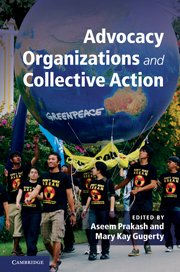Book contents
- Frontmatter
- Contents
- Figures and tables
- Contributors
- Preface
- Acknowledgments
- 1 Advocacy organizations and collective action
- Part 1 The institutional environment and advocacy organizations
- 2 The price of advocacy
- 3 Acting in good faith
- 4 Institutional environment and the organization of advocacy NGOs in the OECD
- Part 2 Advocacy tactics and strategies
- Part 3 International advocacy and market structures
- Part 4 Toward a new research program
- Index
- References
4 - Institutional environment and the organization of advocacy NGOs in the OECD
Published online by Cambridge University Press: 05 June 2012
- Frontmatter
- Contents
- Figures and tables
- Contributors
- Preface
- Acknowledgments
- 1 Advocacy organizations and collective action
- Part 1 The institutional environment and advocacy organizations
- 2 The price of advocacy
- 3 Acting in good faith
- 4 Institutional environment and the organization of advocacy NGOs in the OECD
- Part 2 Advocacy tactics and strategies
- Part 3 International advocacy and market structures
- Part 4 Toward a new research program
- Index
- References
Summary
Research on international advocacy organizations has generally focused on the agency of organizations and their ability to organize campaigns, gather resources, and contact decision-makers to shape foreign policy and international regimes. This is the approach taken in contributions to this volume by Maryann Barakso and McGee Young. In this chapter, I take a slightly different approach and examine the political institutions which frame advocacy. I examine national regulation within OECD countries to gauge variations in the opportunities and costs imposed on international advocacy organizations in different countries. Existing literature sees states and international organizations as targets of advocacy organizations, but governments also make the rules within which domestic and international advocacy organizations operate. In the collective action approach presented in this volume, national regulation determines the costs of organizing, the incentives available to attract members and financing, and available legal identities, thus raising or lowering barriers for international advocacy organizations considering entry. The opportunities and constraints written into national legislation thus shape the choice of locations for international advocacy organizations as they decide where to establish national branches.
This chapter investigates the scope and specifics of national regulation regarding advocacy NGOs within the Organization for Economic Cooperation and Development (OECD). By scope I mean the number and types of regulatory instruments applicable to advocacy organizations in a particular country. I also examine the specific details of regulations, in particular the ability of advocacy organizations in a given country to engage in political and/or economic activities and the process by which organizations gain legal identity and the ability to operate. I address two questions in particular: how do governments approach the regulation of international advocacy organizations and how do regulations vary across OECD members? Governments select among a number of different approaches to regulating international and domestic advocacy organizations, including the use of civil codes, laws specific to associations, and tax codes; prescriptive versus proscriptive rules on behavior; and different levels of specificity producing regulations of very different complexity and stringency. The severity of regulations varies with the number of distinct provisions advocacy operations must follow, while the overall complexity depends on the total length of regulations of which advocacy organizations must be aware. At the end of this chapter, I also assess the relationship between the regulatory approach of governments, including the scope, severity, and complexity of regulation, and the location of international advocacy organizations within the OECD.
- Type
- Chapter
- Information
- Advocacy Organizations and Collective Action , pp. 91 - 130Publisher: Cambridge University PressPrint publication year: 2010
References
- 7
- Cited by



